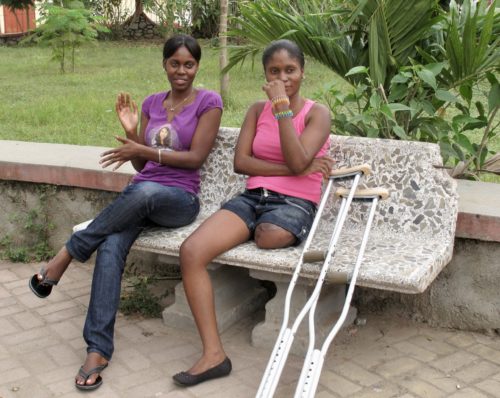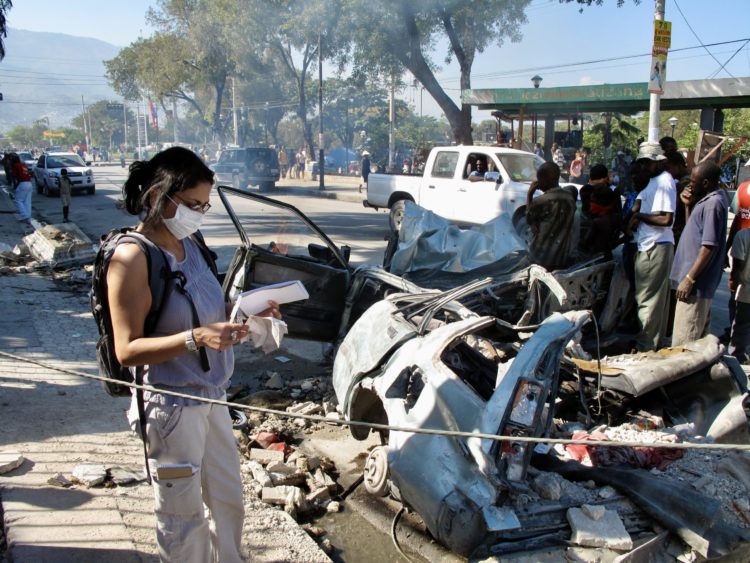“When you don't see something with your own eyes, it’s almost not real.”
Moni Basu wrote three stories about Falone Maxi, a young woman who was with her friend, Mica Joseph, for six days after the 2010 Haiti earthquake destroyed their college. In the first piece, Basu wrote about Maxi and Joseph's experience under the rubble. In the second piece, Moni drove Maxi around Port-au-Prince, which was the first time she had left her makeshift home to see the damage. In the final piece, one year after the earthquake, Basu took Maxi to reunite Joseph, whom she hadn’t seen since their rescue.
As told to Gentry Hale
My first exposure to trauma reporting was through the death penalty. I was taken to interview a man named Marvin Francois. He was on death row, and I interviewed him several days before he was executed.
I was very young — 22, maybe 23. You can imagine what kind of impact it had on me. At a very early age, I was exposed to death and killing and war and murder. That was really the start of my career. I became interested in not just the act of trauma, but human resiliency.

The earthquake in Haiti was on Jan. 13, 2010. CNN did not send me in the first wave of reporters, but I was sent in the second wave, primarily to write news. We had lots of TV crews down there, including Christiane Amanpour, Anderson Cooper and other big names. My job was to latch on with one of those teams and translate their video stories into print stories.
I became frustrated because CNN covered what they called “miracle rescues” every day. There were people being rescued from the rubble of buildings that had collapsed in the earthquake. It was sexy to show footage of someone being pulled out of the rubble in such dramatic fashion and then asking them a few questions like “What was it like to be trapped under a building?” Well, what do you think it was like? It was awful!
I decided to find this woman, Maxi, who had been part of that miracle rescue coverage and go beyond that moment.
The first story
The first time I went to Haiti, I think I stayed six weeks, but I don't remember exactly how long. It's a bit of a blur.
CNN had taken Falone Maxi in one of the CNN trucks to a field hospital, so it was relatively easy to track her down. I went to speak to her at the tent that her mother had set up outside their house. Everyone back then was sleeping outside; we were still experiencing aftershocks.
I remember just sitting by her bedside. I didn't take out a notebook for the first month. I made small talk through my translator. I wanted her to know I wasn't just there to hear how she survived, and then leave. I was genuinely interested in her.
We began talking about where she grew up, who was in her family, what her typical day was like, how much she enjoyed going to college, what kinds of clothes she liked to wear, what she and her friends did. I wanted to know what she was like before this happened. She liked reading romance novels, she liked painting her nails pink, and slowly I got to talking to her about the day of the earthquake.
Related stories
Story Craft: Editor and teacher Jan Winburn’s sensitive guide to covering victims of trauma
Strictly Q&A: John D. Sutter reporting Hurricane Maria
Strictly Q&A: Jessica Ravitz on farmer suicides
I started asking her, “What do you remember about that particular morning? What happened? Can you reconstruct that day for me?”
She told me about the harrowing experience that she had. She also told me that the only reason she survived was because her friend Mica had been trapped with her, and the two women held each other as much as they could. They held on to their hands, they drank their own urine to stay alive and they could feel rats on their feet.
When I left, I reassured her that I would come back. And I did, even after the story was published.
I don't think I consciously sat down and said, “Oh, I have to go back to Haiti because I have to do a follow-up story on Maxi,” but I did know that I didn't want to leave her. As long as I kept going back to Haiti, I would try to find her.
The second story
When I went back to Haiti for the second time, in May, I had already contacted her through my translator and said, “Tell her I'm coming!” It was important for me to see her recovery process.
When I visited her, I realized she hadn't been outside of her home. She had been lying in that bed and had never seen with her own eyes what the earthquake had done. She had seen it on TV, she had seen the footage of everything in ruins, but she hadn't seen it with her own eyes. It's the idea of ambiguous grief: When you don't see something with your own eyes, it’s almost not real.
She looked at me one day and said, “Moni, you have a car. Can you take me around Port-au-Prince?” So we did. That’s when it sank in: “Oh my God, I now understand what happened. Oh my God, I survived it.”
I took her to see her college on the day the bulldozers had arrived to take it all down. If we had gone the next day, it wouldn't have been there. I took a picture of her standing on the rubble site with a big bulldozer in the background.

The third story
The third time I went back to Haiti it was definitely because of her.
Maxi was very close to her mother and her sister, but she had, over the months, kind of withdrawn. This is what happens to a lot of trauma survivors: They don't want to talk to other people who they think will never understand. I decided that I would take her to speak to her friend Mica. It was like she was never going to be whole again until she could speak to the one person who understood what she had gone through. CNN arranged for that visit.
She didn't even know that her friend's leg had been amputated, so it was quite a tearful reunion. I could see that a huge pressure valve had gone off when she saw Mica. She finally was able to talk about a lot of things that she had been processing over the months. Every step of the way she made a little bit more progress, or I'd like to think that, anyway.
My translator translated our stories for her. She loved them. I didn't want her to feel like somehow CNN, this big bad media company, had exploited her in some way. She was really appreciative, and I think that it was a relief knowing that the whole world had seen her story.
For me, it was a metaphorical story. Maxi represented all of Haiti and its healing from the earthquake. When I first met her, I thought, “Oh my gosh. I don't know if this girl will ever recover from the scars of what happened.” But she's done remarkably. I'd like to believe that the process of these stories helped in some way.
***
Gentry Hale was born in Salt Lake City and earned her bachelor’s degree from the University of Utah in environmental and sustainability studies before moving to San Diego to surf for two years. She is working on her master’s in environmental journalism at the University of Montana.



